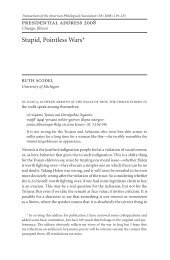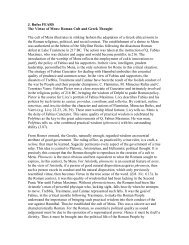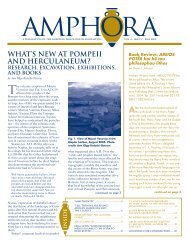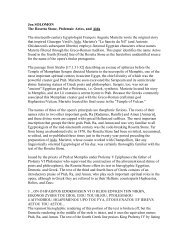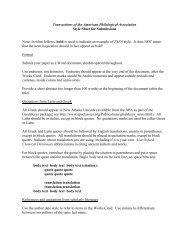classics rewritten in stone: the art of anita huffington - American ...
classics rewritten in stone: the art of anita huffington - American ...
classics rewritten in stone: the art of anita huffington - American ...
You also want an ePaper? Increase the reach of your titles
YUMPU automatically turns print PDFs into web optimized ePapers that Google loves.
PRIOR INCANTATO: GRECO-ROMAN MAGIC FLOWING<br />
FROM J.K. ROWLING’S WAND<br />
cont<strong>in</strong>ued from page 21<br />
Pamphile’s o<strong>in</strong>tments (Apuleius,<br />
Metamorphoses, 3.24-5). Apuleius’ protagonist<br />
would have done well to heed <strong>the</strong><br />
admonition uttered by Pr<strong>of</strong>. McGonagall,<br />
herself an animaga, when she warned<br />
her students, “Transfiguration is some <strong>of</strong><br />
<strong>the</strong> most complex and dangerous magic<br />
you will learn at Hogw<strong>art</strong>s” (SS 8).<br />
Magical creatures such as Lup<strong>in</strong> <strong>the</strong><br />
werewolf (Prisoner <strong>of</strong> Azkaban [PA] 17),<br />
Firenze <strong>the</strong> centaur (SS 15), Fawkes <strong>the</strong><br />
phoenix (CS 12), <strong>the</strong> basilisk (CS 16),<br />
Buckbeak <strong>the</strong> hippogriff (PA 6), Norbert<br />
<strong>the</strong> Norwegian Ridgeback and o<strong>the</strong>r<br />
dragons (GF 19), <strong>the</strong> sph<strong>in</strong>x (GF 31),<br />
and <strong>the</strong>strals (OP 21), all have counterp<strong>art</strong>s<br />
<strong>in</strong> Greco-Roman magical lore.<br />
Lykanthropes, or werewolves, are wellattested<br />
<strong>in</strong> Greco-Roman antiquity<br />
(Ogden 2002). Philostratus records <strong>the</strong><br />
magician Apollonius <strong>of</strong> Tyre’s encounters<br />
with magical creatures on his<br />
sojourn <strong>in</strong> India (3.45-9 for m<strong>art</strong>ichors<br />
[sic], griff<strong>in</strong>s, and phoenixes). The<br />
ghosts and restless dead used to animate<br />
many <strong>of</strong> <strong>the</strong> Greco-Roman curse tablets<br />
have Potterworld counterp<strong>art</strong>s <strong>in</strong> Nearly<br />
Headless Nick (CS 8) and Moan<strong>in</strong>g<br />
Myrtle (CS 16 and GF 25), as well as <strong>in</strong><br />
<strong>the</strong> terrify<strong>in</strong>g <strong>in</strong>feri that guard one <strong>of</strong><br />
Voldemort’s horcruxes (HBP 26-7). The<br />
eponymous sorcerer’s <strong>stone</strong> <strong>of</strong> <strong>the</strong> first<br />
book is rem<strong>in</strong>iscent <strong>of</strong> magical <strong>stone</strong>s <strong>in</strong><br />
general, whe<strong>the</strong>r gem<strong>stone</strong>s <strong>in</strong>scribed<br />
with spells (e.g., Bonner 1950) or <strong>the</strong><br />
belief that <strong>the</strong> <strong>stone</strong>s <strong>the</strong>mselves have<br />
magical properties, for example <strong>the</strong><br />
aff<strong>in</strong>ity <strong>of</strong> hematite for treat<strong>in</strong>g bloodrelated<br />
ailments (for properties <strong>of</strong> magic<br />
<strong>stone</strong>s <strong>in</strong> general, see <strong>the</strong> fourth-century<br />
C.E. Cyranides). The Mirror <strong>of</strong> Erised <strong>in</strong><br />
which viewers see <strong>the</strong>ir true desire f<strong>in</strong>ds<br />
an ancient parallel <strong>in</strong> cataptromancy<br />
(mirror-magic), aga<strong>in</strong>st which Apuleius<br />
arguably defends himself when he<br />
deflects <strong>the</strong> charge that he owns a mirror<br />
(Apuleius, Apologia 13-6). The pensieve,<br />
<strong>in</strong> which Potterworld memories can be<br />
stored, f<strong>in</strong>ds some resonance <strong>in</strong> both<br />
lecanomancy (bowl div<strong>in</strong>ation, e.g., PGM<br />
4.3209-54 a saucer div<strong>in</strong>ation <strong>of</strong><br />
Aphrodite) and even memory spells (eg.<br />
PGM 1.232-47). While <strong>the</strong>re may be no<br />
Greco-Roman <strong>in</strong>visibility cloaks (SS 12<br />
and <strong>the</strong> Tale <strong>of</strong> <strong>the</strong> Three Bro<strong>the</strong>rs), <strong>the</strong>re<br />
are <strong>in</strong>visibility r<strong>in</strong>gs (Cyranides 1.15.33-<br />
7), o<strong>in</strong>tments (PGM 1.222-32), spells<br />
(PGM 7.619-27), and even a cap (Iliad<br />
5.844-5).<br />
But perhaps even more <strong>in</strong>trigu<strong>in</strong>g<br />
than <strong>the</strong>se one-to-one parallels are some<br />
<strong>of</strong> <strong>the</strong> larger ideological issues and<br />
dichotomies: <strong>the</strong> social construction <strong>of</strong><br />
muggles vs. magicians, magic vs. religion,<br />
and magic as susta<strong>in</strong><strong>in</strong>g <strong>of</strong> vs.<br />
threaten<strong>in</strong>g to social order. The answers<br />
to such questions are complex <strong>in</strong> <strong>the</strong><br />
<strong>in</strong>tricately imag<strong>in</strong>ed space <strong>of</strong> Potterworld.<br />
They are a rem<strong>in</strong>der <strong>of</strong> <strong>the</strong> murk<strong>in</strong>ess<br />
<strong>of</strong> <strong>the</strong> categories and oppositions <strong>in</strong><br />
Greco-Roman antiquity. Rowl<strong>in</strong>g’s creation<br />
is a firm rem<strong>in</strong>der that scholars <strong>of</strong><br />
Greco-Roman magic can become so<br />
source-bound that we forget to step back<br />
and imag<strong>in</strong>e an economy <strong>of</strong> magic. The<br />
vicissitudes <strong>of</strong> agon over sport and love<br />
and <strong>the</strong> concerns over knowledge and<br />
transmission are magically manifest <strong>in</strong><br />
Potterworld <strong>in</strong> much <strong>the</strong> way that <strong>the</strong>y<br />
were <strong>in</strong> antiquity. Rowl<strong>in</strong>g’s imag<strong>in</strong>ative<br />
context helps us to envision a way to fill<br />
<strong>the</strong> gaps <strong>in</strong> our understand<strong>in</strong>g <strong>of</strong> <strong>the</strong><br />
recipes and spells at whose users’ needs<br />
we can only guess. Conversely, Potterreaders<br />
may be fasc<strong>in</strong>ated that <strong>the</strong>ir protagonists’<br />
struggles are paralleled by<br />
those <strong>of</strong> real people who lived almost<br />
two millennia ago.<br />
Fur<strong>the</strong>r read<strong>in</strong>g:<br />
C.A. Bonner, Studies <strong>in</strong> Magical Amulets.<br />
Ann Arbor: University <strong>of</strong> Michigan<br />
Press, 1950.<br />
B. C. Daleas, Review <strong>of</strong> Harrius Potter et<br />
Camera Secretorum, trans. by P. Needham,<br />
Amphora 6.2 (Fall 2007): 7, 23.<br />
A. Audollent. Defixionum Tabellae. Paris:<br />
Albert Fontemo<strong>in</strong>g, 1904.<br />
C.A. Faraone, Ancient Greek Love Magic.<br />
Cambridge, MA: Harvard University<br />
Press, 1999.<br />
_______. “The Agonistic Context <strong>of</strong><br />
Early Greek B<strong>in</strong>d<strong>in</strong>g Spells,” <strong>in</strong> Magika<br />
Hiera, edited by C.A. Faraone and<br />
D. Obb<strong>in</strong>k, 3-32. Oxford: Oxford University<br />
Press, 1991.<br />
D. Felton, Haunted Greece and Rome.<br />
Aust<strong>in</strong>: University <strong>of</strong> Texas, 1999.<br />
D. Frankfurter, “Ritual Expertise <strong>in</strong><br />
Roman Egypt and <strong>the</strong> Problem <strong>of</strong> <strong>the</strong><br />
Category <strong>of</strong> <strong>the</strong> ’Magician’,” <strong>in</strong> Envision<strong>in</strong>g<br />
Magic, edited by P. Schäfer and<br />
H.G. Kippenberg, 115-35, Leiden:<br />
Brill, 1997.<br />
D.L. Johnson, Review <strong>of</strong> Areios Poter kai<br />
he tou philosophou lithos, trans. by A.<br />
Wilson, Amphora 4.2 (Fall 2005): 1, 4-5.<br />
L.R. LiDonnici, “Beans, Fleawort, and<br />
<strong>the</strong> Blood <strong>of</strong> a Hamadryas Baboon:<br />
Recipe Ingredients <strong>in</strong> Greco-Roman<br />
Magical Materials,” <strong>in</strong> Magic and Ritual<br />
<strong>in</strong> <strong>the</strong> Ancient World, edited by P.<br />
Mirecki and M. Meyer, 359-77, Leiden:<br />
Brill, 2002.<br />
_________. “Compositional Patterns <strong>in</strong><br />
PGM IV,” Bullet<strong>in</strong> <strong>of</strong> <strong>the</strong> <strong>American</strong> Society<br />
<strong>of</strong> Papyrologists 40 (2003): 141-78.<br />
D. Ogden, Magic, Witchcraft, and Ghosts<br />
<strong>in</strong> <strong>the</strong> Greek and Roman Worlds: A<br />
Sourcebook. Oxford: Oxford University<br />
Press, 2002.<br />
Papyri Graecae Magicae (Preisendanz<br />
1973-74), translated and edited by<br />
H.D. Betz. Greek Magical Papyri <strong>in</strong><br />
Translation. Chicago: University <strong>of</strong><br />
Chicago Press, 1986.<br />
J. Scarborough, “The Pharmacology <strong>of</strong><br />
Sacred Plants, Herbs, and Roots,” <strong>in</strong><br />
Magika Hiera. edited by C.A. Faraone<br />
and D. Obb<strong>in</strong>k, 138-74, Oxford:<br />
Oxford University Press, 1991.<br />
Supplementum Magicum, edited and<br />
translated by R. W. Daniel and F. Maltom<strong>in</strong>i,<br />
Opladen: Westdeutscher Verlag,<br />
1990-92.<br />
J. W<strong>in</strong>kler, “The Constra<strong>in</strong>ts <strong>of</strong> Desire:<br />
Erotic Magic Spells,” <strong>in</strong> The Constra<strong>in</strong>ts<br />
<strong>of</strong> Desire, 71-98. New York: Routledge,<br />
1990.<br />
Elizabeth Ann Pollard (epollard@<br />
mail.sdsu.edu) is Associate Pr<strong>of</strong>essor <strong>of</strong> History<br />
at San Diego State University, where<br />
she has been teach<strong>in</strong>g courses s<strong>in</strong>ce 2002 <strong>in</strong><br />
Greek and Roman history, world history,<br />
women and magic, and <strong>the</strong> historiography <strong>of</strong><br />
witchcraft from Greco-Roman antiquity<br />
through Colonial America. Her most recent<br />
<strong>art</strong>icles have explored writ<strong>in</strong>g about witchcraft<br />
on Wikipedia, images <strong>of</strong> witches <strong>in</strong><br />
Greco-Roman <strong>art</strong>, and plac<strong>in</strong>g Greco-<br />
Roman history and Roman-Indian trade <strong>in</strong><br />
world historical context.<br />
“For human be<strong>in</strong>gs,<br />
words are a weapon sharper<br />
than <strong>the</strong> sword.”<br />
– Pseudo-Phocylides<br />
Wise Say<strong>in</strong>gs, 124.<br />
23



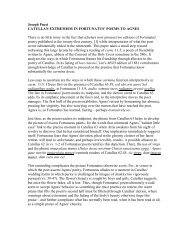
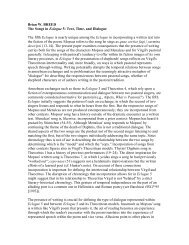
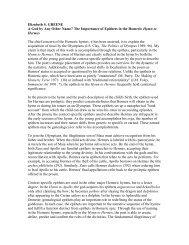

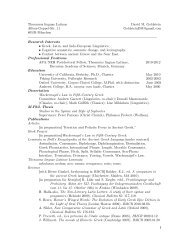
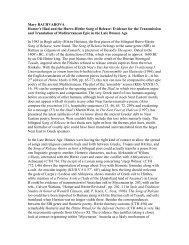

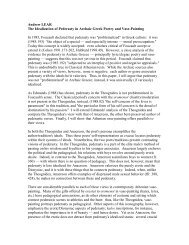
![John H. STARKS, Jr. [vo]cales vultus:Pantomime Actresses in Latin ...](https://img.yumpu.com/11930335/1/190x245/john-h-starks-jr-vocales-vultuspantomime-actresses-in-latin-.jpg?quality=85)
